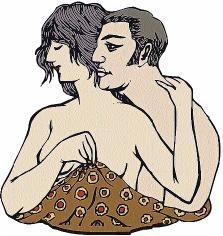
Sex is a universal experience which comes with an array of international similarities and some surprising differences from country to country, among different ages, genders and cultures.
Most people hold an ethnocentric bias to their sexual practices. That is, each person believes that his or her own cultural views and practices are preferable to those of other groups. Cross-cultural studies in sexual behaviour have provided information on universal practices and demonstrate the way cultural standards affect our private and intimate lives.
One's biological sex should be straightforward; either male or female, which determines sex roles. However, in advanced societies, the most rigid sex roles are now relaxing. Though much of man's sexual interaction is biological, anthropological studies show that people in other cultures differ widely in sexual expressions.
Taboo
In expression of sexual feelings, what is accepted as normal in one culture is taboo in another. For example, kissing a partner on the mouth is assumed to be part of normal sexual interaction in Western societies. Yet, in some societies, people do not kiss at all, like the Somali in Africa, the Lepcha of Asia and the Siriono of South America (Gregersen, 1986). Other oral activity like fellatio (oral stimulation of the male genitals) and cunnilingus (of the female genitals) may be practised in one culture and be totally unknown in others. Oral stimulation is not only popular in Western societies, but also in northern Africa, in the South Pacific and in the industrialised countries of Asia. Also, fellatio may be common in one culture, yet cunnilingus is unknown.
Sex play
In Muria, a non-Hindu tribal group in India, children and young adolescents spend their evenings together in the ghotul in sex play and love-making.
For Cheyenne Indians in North America, the young are kept ignorant about sex, and sex play is prohibited. Adults have their sexual life devalued as the focus is only on having children.
In Apinaye, Brazil, during foreplay, the female bites off pieces of the male's eyebrow and spits them aside.
Samoans find the sight of the navel sexually arousing so this portion of the body cannot be exposed in public.
Sleep crawl
Among the Mangaias in Polynesia, only weak males get engaged in order to have sex. Males who are muscular 'sleep crawl' to a girl's house at night, quietly and sweetly talks her out of resisting his sexual overtures and silently have sex with her without waking her parents.
In Gusii in Kenya, as part of the marriage ceremony, the groom is insulted by the bride's family and bride insulted by the groom's family. After the ceremony, groom tries to hurt his bride by thrusting roughly while she cries and resists, often being held down by the groom's friends.
The Yolngu people
Liberal attitudes to childhood sexuality were found among the Yolngu people on Elcho island in Australia. Eight-year-olds will describe how two six-year-olds demonstrated 'nigi nigi' (sexual intercourse) at a campfire the night before. Both adults and children find the stories hilarious. Though amusing, adults believe that it is acceptable for children to pretend to have intercourse. In Western cultures, adults would feel uncomfortable watching children embracing on the floor, thrusting the pelvis and other actions to imitate adult sexual interactions.
When children are crying, the Yolngu adults soothe them by stroking their genitals. It was the European settlers who fought against nudity once accepted from infancy through old age. Children of both sexes would shower together with no inquiry about the differences in sexual anatomy. Sex play is common among children with same-sex and opposite-sex partners. Masturbation is accepted and details of menstruation are taught to females long before puberty.
Multiple wives
The Yolngu are not without sexual problems despite their liberal attitude to sex. In a culture where males are dominant, they can have several wives including sisters, and have sex with the wife they choose. Men live a relatively free life as they do not have to take care of the children nor help with domestic responsibilities.
The polygamous practice among the Yolngu gives the females little choice in the selection of a mate and they are expected to marry as soon as they reach puberty. Very young girls must accept relatively older men as husbands and they are expected to have as many children as possible. However, homosexuality, rape and child abuse are not known.
In other cultures, homosexuality is forbidden or severely restricted. Anal intercourse is the most common act among male homosexuals in non-industrialised, tribal societies. The Ila of Africa believe that men can become pregnant, so homosexual intercourse between men are forbidden.
Contraceptive potion
In New Guinea, the Keraki hold similar beliefs and have developed a homosexual ritual in which boys drink a contraceptive potion. For Sambians, living the mountains of New Guinea, homosexual activity is required from age seven to when they marry at which time they shift to heterosexual behaviour (Gregersen, 1983).
In India, true social norms prohibit pre-marital sex. Despite the strong biological need, Indians believe that sex after marriage is a medium of expressing love between couples. If sex becomes a mere need of the body, then its enjoyment in the true sense becomes monotonous. In response to curbing their baser instincts, people find creative outlets to meet the urges arising for sex before marriage. Some may even engage in singing devotional in temples.
Sex and agriculture
History has shown that several countries associate sexuality with agriculture. In some American Indian tribes, sexual acts took place just before the seeds were planted. However, it was important to abstain from sex at planting time. Ancient Sumerians required that religious dignitaries perform sexual intercourse with each other to ensure a rich harvest.
Every person has attitudes, biases and values about different sexual practices shaped by their culture. It is culture that influences the differing ideas about what people consider to be 'sex'.